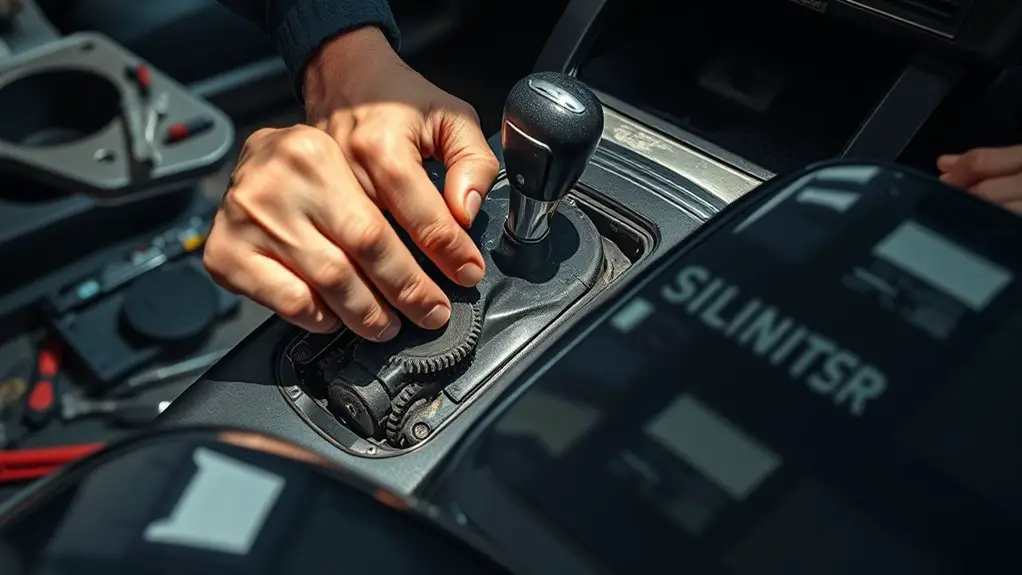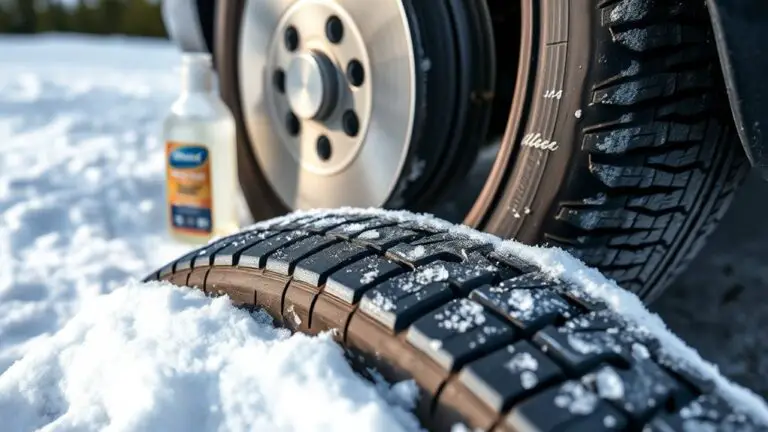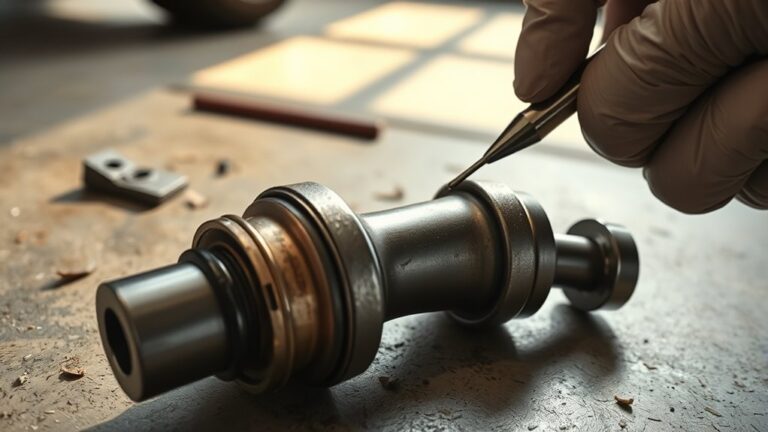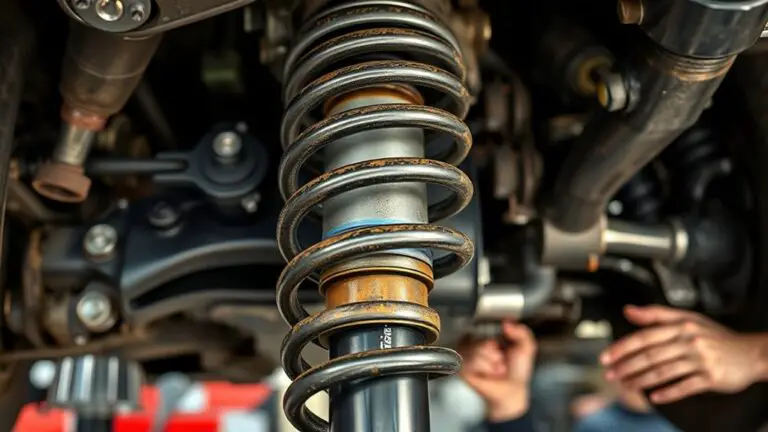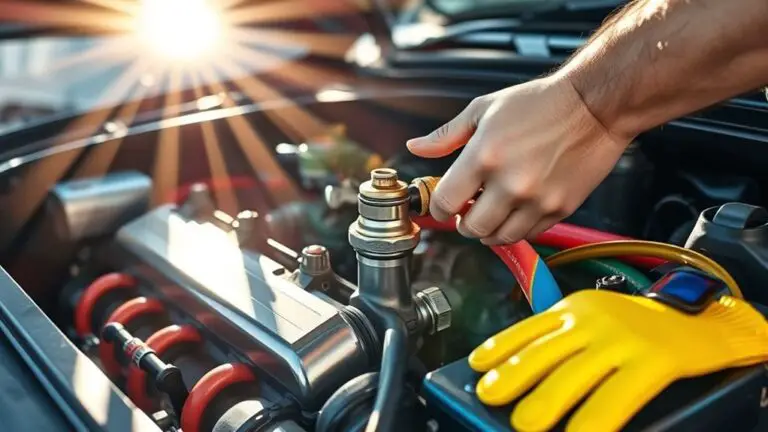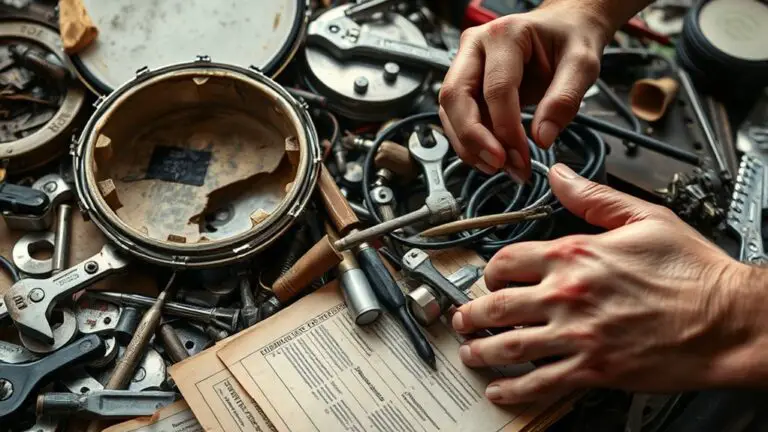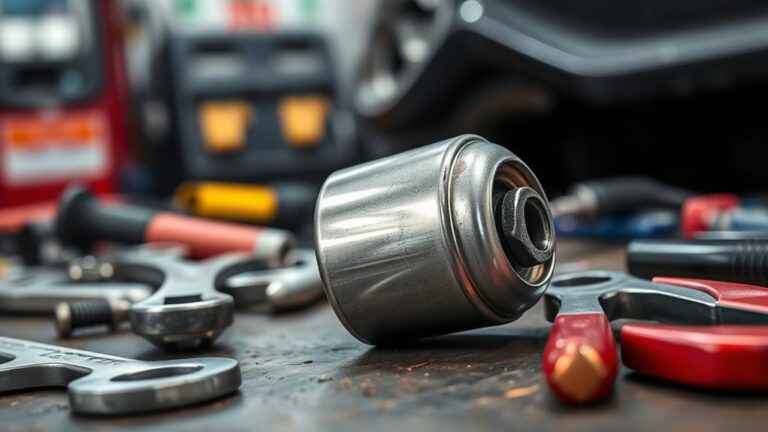Troubleshooting Slipping Gears in a Manual Sedan
If you’re experiencing slipping gears in your manual sedan, it’s vital to act promptly. Check for worn clutch components, low transmission fluid, or damaged gear linkages. Unusual RPM fluctuations and difficulty shifting are common signs of gear slippage. Inspect your clutch for excessive wear and guarantee proper transmission fluid levels and quality. If basic troubleshooting doesn’t resolve the issue, consulting a mechanic might be necessary to prevent further damage. Explore additional steps to maintain your vehicle’s performance.
Understanding Slipping Gears: What It Means
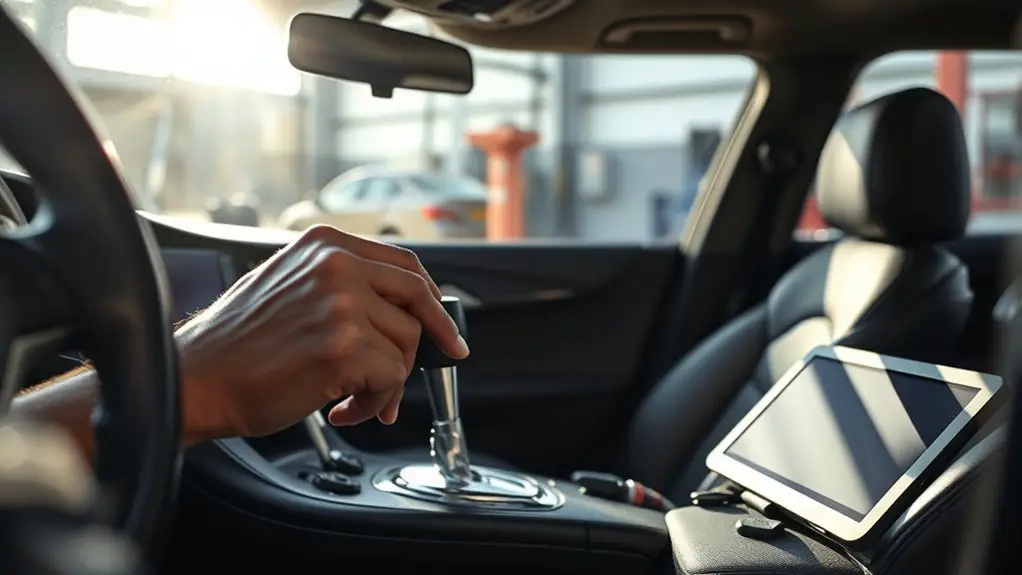
When you’re driving a manual sedan, slipping gears can signal a serious issue that demands your attention. This phenomenon occurs when there’s a failure in gear engagement, causing the transmission to momentarily lose connection with the engine. In a manual transmission, each gear must mesh properly to guarantee peak power transfer. When gears slip, you might experience a sudden loss of acceleration or an unexpected rev in engine speed, which can be disconcerting.
Understanding slipping gears is vital for maintaining the performance and safety of your vehicle. It often indicates underlying problems like worn clutch components or damaged synchronizers, which may compromise your driving experience. Ignoring these signs can lead to more severe transmission issues, ultimately limiting your freedom on the road. Regular inspection and timely maintenance can help you preserve the reliability of your manual transmission and enhance your driving pleasure.
Common Causes of Slipping Gears
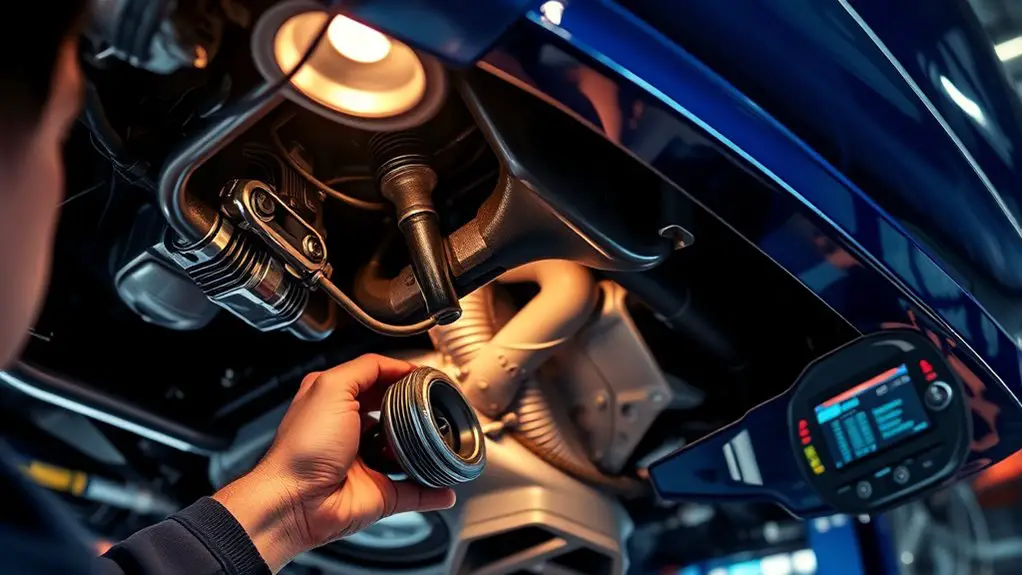
Slipping gears in your manual sedan can often stem from worn clutch components or low transmission fluid levels. If the clutch isn’t engaging properly, it can lead to difficulty in shifting and a loss of power. Similarly, insufficient transmission fluid can result in inadequate lubrication and overheating, both contributing to gear slippage.
Worn Clutch Components
Worn clutch components are often the primary culprits behind gear slipping in manual sedans. When you experience clutch wear, it can lead to a loss of friction between the clutch disc and flywheel, making it difficult to engage gears smoothly. This wear can stem from frequent stop-and-go driving, improper clutch usage, or simply age. If you notice a burning smell or difficulty shifting, it’s essential to address the issue promptly. Ignoring these signs can lead to more extensive damage. In such cases, clutch replacement may become necessary to restore proper function. Regular maintenance and inspections can help you prevent these issues and maintain the freedom that comes with driving a manual sedan.
Low Transmission Fluid
Clutch issues aren’t the only reason you might experience slipping gears in your manual sedan. Low transmission fluid can greatly impact your vehicle’s performance. When fluid levels drop, the transmission lacks the necessary lubrication, leading to increased friction and potential gear slippage. Regular transmission maintenance is vital; check your fluid levels routinely to avoid this issue. If you notice your gears slipping, inspect the transmission fluid for discoloration or a burnt smell, as these can indicate contamination. Addressing low fluid levels promptly can prevent severe damage and costly repairs, ensuring you maintain the freedom and control you desire while driving. Don’t overlook this essential aspect of your vehicle’s upkeep; keep your transmission healthy and responsive.
Signs Your Gears Are Slipping

If you’re experiencing unusual engine RPM fluctuations, it’s a clear sign your gears might be slipping. You may also notice difficulty shifting gears or hear grinding or crunching noises when attempting to change gears. Recognizing these symptoms early can help prevent further damage to your transmission system.
Unusual Engine RPM Fluctuations
When you notice unusual engine RPM fluctuations, it can indicate that your gears are slipping, creating an unsettling driving experience. These fluctuations often manifest as sudden increases or decreases in RPM without corresponding changes in speed. To diagnose this issue, conduct an RPM analysis while driving. If the engine’s performance seems erratic, it may signal that the clutch isn’t fully engaging, or the transmission fluid is low or contaminated. Ignoring these signs can lead to further damage and reduced driving freedom. Regular monitoring of your vehicle’s performance can help catch these fluctuations early, allowing you to address the underlying problems before they escalate. Stay proactive to guarantee a smooth, reliable driving experience.
Difficulty Shifting Gears
Difficulty shifting gears is another clear sign that your transmission may be experiencing slipping issues. In a manual transmission, proper gear engagement is essential for smooth operation. If you notice resistance when shifting or the gear stick feels loose, it’s likely an indication that the gears aren’t properly engaging. You might also find that you need to apply more force than usual to change gears, or that the car doesn’t respond as expected when you shift. These symptoms can disrupt your driving experience and compromise your vehicle’s performance. Addressing the underlying issues promptly guarantees that you maintain control and enjoy the freedom of driving your manual sedan without hesitation.
Grinding or Crunching Noises
While driving your manual sedan, hearing grinding or crunching noises when shifting gears can be a clear indicator that your transmission is slipping. These grinding gears suggest that the synchronizers may be worn, causing poor engagement between the gears. If you don’t address this issue promptly, it could lead to more severe transmission damage. Noise reduction techniques, such as regular maintenance and proper gear oil levels, can help minimize these sounds, but they won’t resolve underlying problems. It’s essential to inspect your clutch and transmission components if you notice these noises. Ignoring them might compromise your driving freedom. Always consult a qualified mechanic to diagnose and fix the issue to guarantee peak performance and safety on the road.
Checking the Clutch: A Key Component
Checking the clutch is crucial for diagnosing slipping gears in a manual sedan. Start by inspecting for clutch wear, which can greatly affect performance. If the pedal feels spongy or engages high in the travel, it may indicate excessive wear. You’ll want to measure the clutch disc thickness and look for signs of glazing or burning.
Next, assess the clutch adjustment. An improperly adjusted clutch can lead to insufficient engagement, causing gears to slip. If your clutch pedal isn’t set to the manufacturer’s specifications, it can hinder your driving freedom. Adjusting the clutch cable or hydraulic system can rectify this issue, providing a smoother engagement and better control.
Don’t overlook these steps; a well-functioning clutch is crucial for maintaining the performance and reliability of your manual sedan. Addressing clutch wear and making necessary adjustments can keep your driving experience enjoyable and trouble-free.
Transmission Fluid: Importance and Maintenance
Transmission fluid plays an essential role in the overall performance and longevity of your manual sedan’s gearbox. It lubricates the moving parts, reduces friction, and helps maintain optimal temperatures. Regular transmission maintenance is vital; low or dirty fluid can lead to slipping gears and costly repairs.
You should check your fluid levels frequently, ideally every few months or before long trips. If you notice the fluid is dark or has a burnt smell, it’s time for a change. When topping off, use the manufacturer-recommended type of fluid to guarantee compatibility and effectiveness.
Inspecting the Gear Linkage
If you’re experiencing slipping gears, inspecting the gear linkage is an essential step in diagnosing the issue. Begin by checking the gear cables for proper adjustment. If they’re too loose or too tight, it can lead to misalignment, causing the gears to slip. Adjust the cables as needed to guarantee a smooth shift between gears.
Next, look for signs of linkage wear. Over time, components can wear down, leading to imprecise gear engagement. Inspect the linkage for any signs of fraying, cracking, or excessive play. If you notice considerable wear, consider replacing the affected parts to restore proper functionality.
Finally, lubricate the linkage joints to minimize friction and enhance performance. By guaranteeing proper gear cable adjustment and addressing any linkage wear, you’ll greatly improve your manual sedan’s shifting performance and regain the freedom of smooth driving.
Diagnosing Potential Transmission Issues
While inspecting the gear linkage is essential, diagnosing potential transmission issues is equally important when dealing with slipping gears. Different transmission types—manual, automatic, or CVT—can exhibit unique symptoms and failure modes. You’ll want to pay close attention to the gear ratios. If a specific gear feels unusually high or low, it may indicate problems.
- Feeling the thrill of the open road can be fleeting.
- The freedom of a smooth ride shouldn’t be compromised.
- Your journey shouldn’t be marred by mechanical woes.
Start by checking for fluid leaks, which can lead to low transmission fluid levels, affecting performance. Additionally, listen for unusual noises when shifting gears; these can signal internal problems. Finally, consider the clutch system’s condition, as a worn-out clutch can mimic transmission failure. Addressing these issues promptly can help you maintain that exhilarating driving experience you cherish.
When to Seek Professional Help
Recognizing when to seek professional help is essential for effectively addressing slipping gears in your manual sedan. If you’ve tried basic troubleshooting, such as checking fluid levels or inspecting the clutch pedal, and the issue persists, it’s time to consult a mechanic. Ignoring persistent slipping can lead to more severe transmission damage, jeopardizing your vehicle’s performance and your safety.
Professional services provide the mechanic expertise necessary to diagnose complex problems that may not be immediately apparent. If you’re experiencing unusual noises, vibrations, or difficulty shifting gears, don’t hesitate to reach out to a qualified technician. They can assess the condition of your transmission, identify underlying issues, and recommend appropriate repairs.
Preventive Measures to Avoid Future Problems
After addressing slipping gears and consulting a professional, implementing preventive measures can greatly enhance the longevity and performance of your manual sedan’s transmission. Prioritizing preventive maintenance and conducting regular inspections can help you avoid future issues that could compromise your driving experience.
- Feel the thrill of smooth gear shifts on every drive.
- Enjoy the freedom of knowing your car is reliable and ready for adventure.
- Save money by preventing costly repairs down the road.
To start, change your transmission fluid according to your manufacturer’s guidelines. This guarantees optimal lubrication and reduces wear. Additionally, inspect your clutch system regularly, as it plays a vital role in smooth gear changes. Finally, be mindful of your driving habits; aggressive shifting can lead to premature wear. By taking these steps, you can maintain the performance of your manual sedan and enjoy every mile on the road.
Frequently Asked Questions
Can Driving Style Affect Gear Slipping in Manual Sedans?
Yes, your driving style can definitely affect gear slipping in manual sedans. If you’re abrupt with your shifting technique or have inconsistent driving habits, it can lead to premature wear on the transmission components. Smooth, precise shifts and proper clutch engagement help maintain the integrity of the gearbox. By refining your driving habits, you not only enhance performance but also extend the life of your vehicle’s transmission. So, practice a gentle touch!
How Often Should I Check My Clutch Condition?
You should check your clutch condition every six months as part of your maintenance schedule. Clutch wear can sneak up on you, so staying proactive guarantees your ride remains reliable. Look for signs like unusual noises or difficulty shifting, as they may indicate deeper issues. Regular inspections will help maintain peak performance and provide the freedom you desire while driving. Don’t let neglect turn your smooth shifts into slipping struggles!
Will Using Different Transmission Fluid Cause Slipping?
Yes, using different transmission fluid can cause slipping. It’s vital to guarantee transmission fluid compatibility; using an incompatible fluid may lead to improper lubrication and performance issues. Additionally, the fluid viscosity impact can’t be ignored; too thick or too thin fluid can hinder your transmission’s ability to shift smoothly. Stick with the manufacturer’s recommended fluid to maintain peak performance and avoid slipping gear problems, allowing you the freedom to drive confidently.
Can Weather Conditions Impact Gear Performance?
Absolutely, weather conditions can impact gear performance. Just like a chameleon adapts to its surroundings, your vehicle’s transmission responds to temperature effects and moisture levels. Cold weather can thicken transmission fluid, leading to sluggish shifts, while humidity can introduce moisture that hampers performance. It’s essential to monitor these factors, as they can affect your driving experience and the freedom you feel on the road. Regular maintenance helps mitigate these weather-related issues.
Are There Specific Brands of Transmission Fluid Recommended?
Yes, there are specific brands of transmission fluid recommended for ideal performance. You’ll want to look for fluids that match your vehicle’s specifications, focusing on transmission fluid types like synthetic or conventional. Pay attention to fluid viscosity ratings, as they can greatly impact shifting smoothness and longevity. Brands like Mobil 1, Valvoline, and Castrol often receive high marks for quality, ensuring your manual transmission runs efficiently and reliably.

